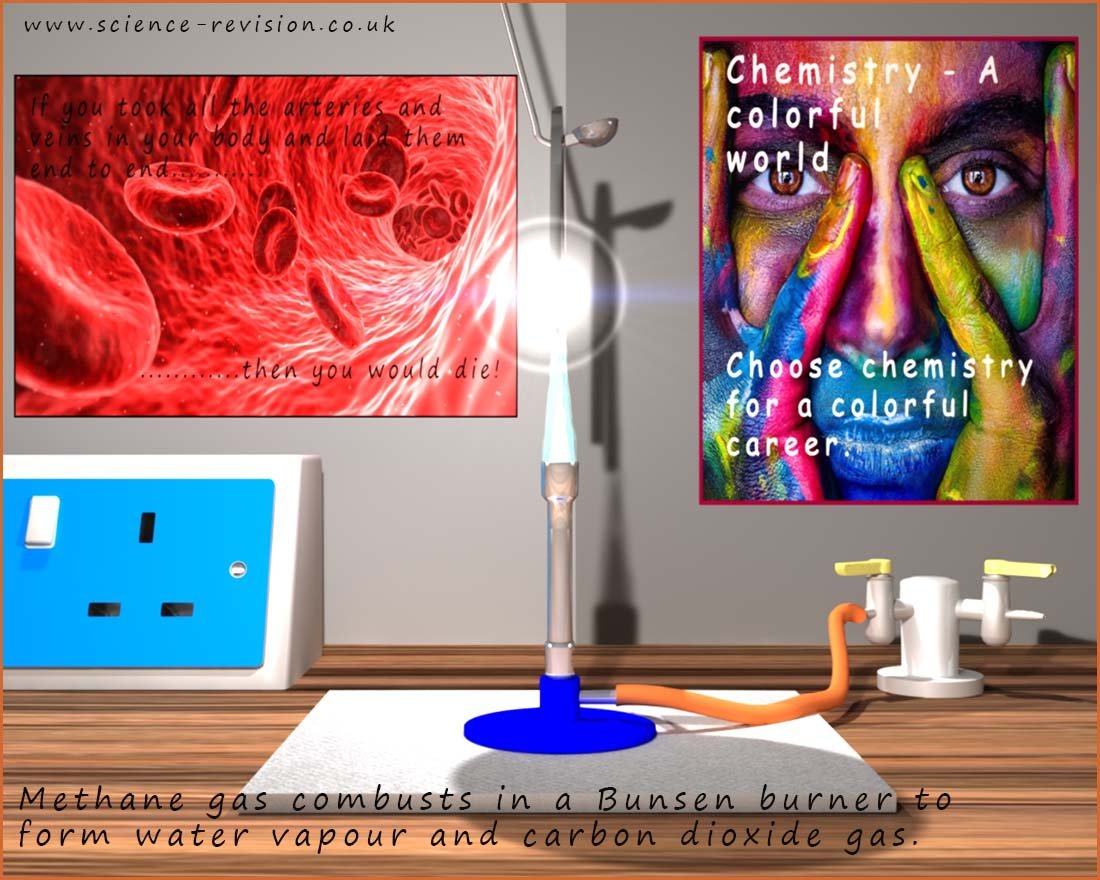

 The enthalpy change (ΔH) for a reaction represents
the amount of heat energy released at constant pressure when the
reactants are changed into products during a chemical reaction, its value is expressed in kilojoules (kJ) or
kilojoules per mole (kJ mol-1). As an example consider the combustion
of methane gas in a Bunsen burner to form carbon dioxide and water. Two equations are shown below for this combustion reaction.
The enthalpy change (ΔH) for a reaction represents
the amount of heat energy released at constant pressure when the
reactants are changed into products during a chemical reaction, its value is expressed in kilojoules (kJ) or
kilojoules per mole (kJ mol-1). As an example consider the combustion
of methane gas in a Bunsen burner to form carbon dioxide and water. Two equations are shown below for this combustion reaction.
Each of the two equations is balanced. When we write equations to represent an enthalpy change (ΔH) it is important that a number of other factors are made clear, these include:
To ensure that all enthalpies are recorded in a similar way and to make it possible to compare enthalpy changes for different reactions chemists use a set of conditions called standard condition. Standard conditions are:
The standard enthalpy change (ΔHo) for a reaction is the enthalpy change
under standard conditions (298K, 100kPa,) with all
reactants and products being in their standard states.
Under standard conditions the standard or most stable state of water is a liquid at 298K and 100kPa, while methane, oxygen and carbon dioxide are all gases. So this means that the second of the two equations above for the combustion of methane, that is:
The standard enthalpy of combustion of a substance is the enthalpy change that occurs under standard conditions, when 1 mol of a substance is completely burned in oxygen, with all reactants and products being in their standard states.
There are many enthalpy changes
you will learn about as you complete your A-level chemistry course. The standard enthalpy of formation
is simply one of these. In the example above using standard enthalpies of combustion, one mole of a substance was
completed burned in
oxygen. Well as the name suggests the enthalpy of formation
is the enthalpy change when 1 mole of a substance
is formed under standard conditions from its elements, with
all reactants and products
being in their standard states. For example the equation to
show the standard enthalpy of
formation (ΔfHo) of methane would be:
The element carbon exists in two forms or allotropes, diamond and graphite. The most stable allotrope of
carbon is graphite which will be the standard state used in
enthalpy change calculations. You may see this written as Cgraphite in some web pages and
textbooks.
You should be aware that when you come to carry out enthalpy calculations using
enthalpies of formation that by definition the standard enthalpy of formation
of
an element is by definition 0. This may not at first seem obvious but if you think about what an
enthalpy change of formation is then it should be apparent. The enthalpy
of formation (ΔfHo) is the enthalpy change (amount of heat released at constant pressure) when
a substance
is formed from the most stable form of its elements. Or you can think of the reactants
as the initial state and the product as the final state in the
enthalpy change taking place.
However with an element there is NO enthalpy change
taking place because the reactants and products
are the same. The element is already formed so no enthalpy of
formation is possible, the element cannot react to form itself! Setting the enthalpy of formation
for an element to O is a good choice since we cannot measure the enthalpy of
substances anyway, we can only measure enthalpy changes. So the setting of the enthalpy of formation of an element
to 0 is an obvious choice for setting a relative reference or starting point.
If you were asked to write an equation to show the standard enthalpy of combustion (ΔcHo)
of carbon you would write: